Feature
Nursing Uniforms Through History
Today’s scrubs are a long way from the starched gowns and white caps of earlier eras

Modern scrubs are practical, cheap and easy to care for, but there was something elegant about the nursing uniforms of ages past: long, floor-sweeping skirts; beautifully crisp aprons; neat cuffs; high collars; and of course white nurse’s caps.
Traditional starched white uniforms are rarely seen today except in period dramas, but they’re still an important part of our profession’s history and visual iconography.
Laundry Day
When I was a young girl, my grandmother, a former laundress, would entertain me with stories about the laundry at Bellevue Hospital in New York. She would talk about the endless loads of smocks, aprons and caps that needed to be starched and ironed for the nurses. She and the other laundresses took pride in getting the pleats just right.
During her tenure, the laundries used flat irons that were heated over burning coals. You had to have two going at all times to keep up the pace: one in use and one heating up. The nurses would pick up their packages of clean uniforms and occasionally leave tokens of appreciation, especially during the holidays.
Today, nurses are expected to wash their own work clothes on their own time. Fortunately, that’s far easier than it was in my grandmother’s day: You just toss your scrubs into the washer, tumble dry and wear the next day. Most of us wouldn’t even think of taking the time to iron our scrubs, much less reach for the starch.
From Nun’s Habit to Candy Striper
Many traditional nursing uniforms were modeled on the garments of religious orders, which in turn reflected the clothing styles common at the time that order or congregation was originally founded. (Sisters might go centuries before updating their look!)
Nurses of earlier eras were as much maids as clinicians, and their garb echoed that menial role: large aprons, indoor caps and large pockets. Not until the early 1900s did nursing uniforms begin to adopt elements like distinctive capes, arm bands and pins that indicated the nurse’s professional stature.












